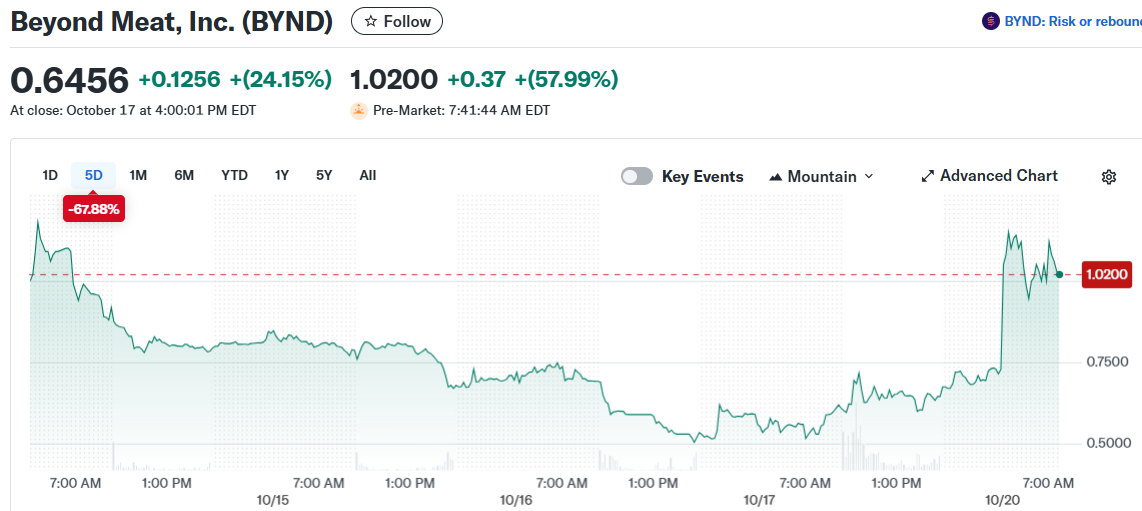TLDR
- Beyond Meat stock jumped 50% on October 17 in a short squeeze after falling below $1, with trading volume exploding to 438 million shares compared to the normal 13 million.
- The company completed a debt-for-equity swap that issued 316 million new shares, more than quadrupling the outstanding share count and creating what analysts call massive dilution for existing shareholders.
- The stock now trades around $0.65, down 97% from its 2019 peak of $239, putting it in penny stock territory near its 52-week low of $0.50.
- Revenue dropped 20% year-over-year to $75 million in Q2 2025, with the company holding only $117 million in cash against $1.2 billion in debt.
- Wall Street maintains a consensus “Strong Sell” rating with a median price target of $3, while short interest sits at roughly 64% of the float, making it one of the most-shorted U.S. stocks.
Beyond Meat’s stock exploded 50% on October 17 in one of the wildest trading sessions the company has ever seen. The surge wasn’t driven by good news or a business turnaround. It was a short squeeze, pure and simple.

Trading volume hit 438 million shares that day. That’s compared to the normal 13 million. Short sellers who had bet against the stock rushed to cover their positions, sending the price up despite terrible fundamentals.
The stock closed around $0.65. That’s penny stock territory. It’s down 97% from the 2019 peak of $239.
The recent volatility traces back to October 13. That’s when Beyond Meat completed a debt-for-equity swap designed to reduce its massive debt load. The company issued 316 million new shares to bondholders.
Before the swap, only 76.7 million shares were outstanding. The new issuance more than quadrupled the share count overnight. Analysts called it a “huge dilution bomb” for existing shareholders.
The stock initially crashed over 50% on news of the swap. It fell below $1 as investors panicked about the dilution. Shares bottomed around $0.50 during the sell-off.
Then came the lock-up expiry on October 17. About 60 to 63 million of the newly issued shares hit the market. This should have pushed the stock even lower.
Instead, it rallied 24.6% that Friday. The counter-intuitive move was driven by short sellers covering their positions. With 64% of the float sold short, Beyond Meat ranks as one of the most-shorted stocks in the U.S.
Revenue Collapse and Analyst Downgrades
The squeeze happened against a backdrop of deteriorating business fundamentals. Second quarter revenue dropped 20% year-over-year to just $75 million, missing analyst estimates.
The company withdrew its full-year guidance. Analysts now expect 2025 revenue to fall about 14% to roughly $282 million. That continues a multi-year trend of declining sales.
Cash on hand stands at only $117 million. Total debt is $1.2 billion. The company has racked up $931 million in operating losses since 2021.
CEO Ethan Brown recently acknowledged that “animal meats are in the true cyclical fashion of consumer trends, leaving less room for our products and brand.” The entire plant-based meat sector is shrinking. A Good Food Institute study found U.S. alternative meat revenues down 18% over two years.
Wall Street Turns Bearish
The analyst community has turned overwhelmingly negative. Beyond Meat carries a consensus “Strong Sell” rating. Zero of the nine covering analysts recommend buying the stock.
The median 12-month price target sits at $3. That’s nearly five times the current price, but still implies a market cap of only about $200 million. TD Cowen recently cut its target to just $0.80.
Argus downgraded the stock to “Sell.” Cowen warned of an “existential threat” without a swift turnaround. Industry watchers describe the company as trapped in a “death spiral” of falling demand and crushing dilution.
Institutional investors have largely exited their positions. Insiders have sold tens of millions of shares. That’s a far cry from the enthusiasm that surrounded the company’s 2019 IPO.
On October 20, the stock surged another 70% in pre-market trading, jumping from $0.64 to $1.08. The move appears to be another wave of short covering rather than any change in the underlying business.
Call option trading spiked to 110,588 contracts on October 17, up 151% from normal levels. Speculators are betting that the short squeeze has more room to run given the massive short interest overhang.
The debt restructuring does provide some relief. The company issued $208.7 million in new 7% notes due in 2030, extending maturities and slightly reducing interest expenses. But that came at the cost of massive shareholder dilution.
The stock remains well below its 50-day moving average of $2.37. It’s trading at a fraction of the $6 to $7 range it briefly hit last August.
Whether the squeeze continues depends on how long shorts stay nervous and whether retail traders pile in. But most analysts expect the stock to resume its decline once the frenzy fades. The short squeeze was dramatic, but the underlying business still needs to prove it can stabilize sales and generate cash.






